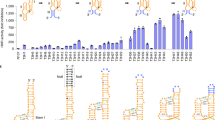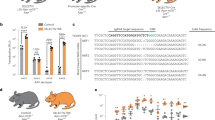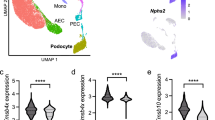Abstract
Effective gene therapy strategies for the treatment of kidney disorders remain elusive. We report an optimized kidney-targeted gene delivery strategy using recombinant adeno-associated virus (rAAV) administered via retrograde renal vein injection in mice. Renal vein injection of rAAV consistently resulted in superior kidney transduction compared with tail vein injection using as little as half the tail vein dose. We compared rAAV5, 6, 8 and 9, containing either green fluorescent protein (GFP) or luciferase reporter genes driven by the Cytomegalovirus promoter. We demonstrated that although rAAV6 and 8 injected via renal vein transduced the kidney, transgene expression was mainly restricted to the medulla. Transgene expression was systematically low after rAAV5 injection, attributed to T-cell immune response, which could be overcome by transient immunosuppression. However, rAAV9 was the only serotype that permitted high-transduction efficiency of both the cortex and medulla. Moreover, both the glomeruli and tubules were targeted, with a higher efficiency within the glomeruli. To improve the specificity of kidney-targeted gene delivery with rAAV9, we used the parathyroid hormone receptor ‘kidney-specific’ promoter. We obtained a more efficient transgene expression within the kidney, and a significant reduction in other tissues. Our work represents the first comprehensive and clinically relevant study for kidney gene delivery.
This is a preview of subscription content, access via your institution
Access options
Subscribe to this journal
Receive 12 print issues and online access
$259.00 per year
only $21.58 per issue
Buy this article
- Purchase on Springer Link
- Instant access to full article PDF
Prices may be subject to local taxes which are calculated during checkout





Similar content being viewed by others
References
Knoll G . Trends in kidney transplantation over the past decade. Drugs 2008; 68: 3–10.
Davis CL, Delmonico FL . Living-donor kidney transplantation: a review of the current practices for the live donor. J Am Soc Nephrol 2005; 16: 2098–2110.
Cecka JM . Kidney transplantation in the United States. Clin Transpl 2008; 1–18.
Maruyama H, Higuchi N, Nishikawa Y, Hirahara H, Iino N, Kameda S et al. Kidney-targeted naked DNA transfer by retrograde renal vein injection in rats. Hum Gene Ther 2002; 13: 455–468.
Beckmann CF, Abrams HL . Renal venography: anatomy, technique, applications, analysis of 132 venograms, and a review of the literature. Cardiovas Intervent Radiol 1980; 3: 45–70.
Mingozzi F, High KA . Therapeutic in vivo gene transfer for genetic disease using AAV: progress and challenges. Nat Rev Genet 2011; 12: 341–355.
Daya S, Berns KI . Gene therapy using adeno-associated virus vectors. Clin Microbiol Rev 2008; 21: 583–593.
Arruda VR, Xiao W . It's all about the clothing: capsid domination in the adeno-associated viral vector world. J Thromb Haemost 2007; 5: 12–15.
Coura Rdos S, Nardi NB . The state of the art of adeno-associated virus-based vectors in gene therapy. Virol J 2007; 4: 99.
Choi VW, McCarty DM, Samulski RJ . AAV hybrid serotypes: improved vectors for gene delivery. Curr Gene Ther 2005; 5: 299–310.
Lipkowitz MS, Hanss B, Tulchin N, Wilson PD, Langer JC, Ross MD et al. Transduction of renal cells in vitro and in vivo by adeno-associated virus gene therapy vectors. J Am Soc Nephrol 1999; 10: 1908–1915.
Chen S, Agarwal A, Glushakova OY, Jorgensen MS, Salgar SK, Poirier A et al. Gene delivery in renal tubular epithelial cells using recombinant adeno-associated viral vectors. J Am Soc Nephrol 2003; 14: 947–958.
Takeda S, Takahashi M, Mizukami H, Kobayashi E, Takeuchi K, Hakamata Y et al. Successful gene transfer using adeno-associated virus vectors into the kidney: comparison among adeno-associated virus serotype 1-5 vectors in vitro and in vivo. Nephron Exp Nephrol 2004; 96: e119–e126.
Qi YF, Li QH, Shenoy V, Zingler M, Jun JY, Verma A et al. Comparison of the transduction efficiency of tyrosine-mutant adeno-associated virus serotype vectors in kidney. Clin Exp Pharmacol Physiol 2013; 40: 53–55.
Bainbridge JW, Smith AJ, Barker SS, Robbie S, Henderson R, Balaggan K et al. Effect of gene therapy on visual function in leber's congenital amaurosis. N Engl J Med 2008; 358: 2231–2239.
Maguire AM, Simonelli F, Pierce EA, Pugh EN Jr, Mingozzi F, Bennicelli J et al. Safety and efficacy of gene transfer for leber's congenital amaurosis. N Engl J Med 2008; 358: 2240–2248.
Manno CS, Pierce GF, Arruda VR, Glader B, Ragni M, Rasko JJ et al. Successful transduction of liver in hemophilia by AAV-Factor IX and limitations imposed by the host immune response. Nat Med 2006; 12: 342–347.
Boutin S, Monteilhet V, Veron P, Leborgne C, Benveniste O, Montus MF et al. Prevalence of serum IgG and neutralizing factors against adeno-associated virus (AAV) types 1, 2, 5, 6, 8, and 9 in the healthy population: implications for gene therapy using AAV vectors. Hum Gene Ther 2010; 21: 704–712.
Yue Y, Ghosh A, Long C, Bostick B, Smith BF, Kornegay JN et al. A single intravenous injection of adeno-associated virus serotype-9 leads to whole body skeletal muscle transduction in dogs. Mol Ther 2008; 16: 1944–1952.
Katwal AB, Konkalmatt PR, Piras BA, Hazarika S, Li SS, John Lye R et al. Adeno-associated virus serotype 9 efficiently targets ischemic skeletal muscle following systemic delivery. Gene ther 2013; 20: 930–938.
Prasad KM, Xu Y, Yang Z, Acton ST, French BA . Robust cardiomyocyte-specific gene expression following systemic injection of AAV: in vivo gene delivery follows a Poisson distribution. Gene Ther 2011; 18: 43–52.
Suda T, Liu D . Hydrodynamic gene delivery: its principles and applications. Mol Ther 2007; 15: 2063–2069.
Wang G, Zabner J, Deering C, Launspach J, Shao J, Bodner M et al. Increasing epithelial junction permeability enhances gene transfer to airway epithelia in vivo. Am J Respir Cell Mol Biol 2000; 22: 129–138.
Herweijer H, Wolff JA . Gene therapy progress and prospects: hydrodynamic gene delivery. Gene Ther 2007; 14: 99–107.
Takemoto M, Asker N, Gerhardt H, Lundkvist A, Johansson BR, Saito Y et al. A new method for large scale isolation of kidney glomeruli from mice. Am J Pathol 2002; 161: 799–805.
McIntosh JH, Cochrane M, Cobbold S, Waldmann H, Nathwani SA, Davidoff AM et al. Successful attenuation of humoral immunity to viral capsid and transgenic protein following AAV-mediated gene transfer with a non-depleting CD4 antibody and cyclosporine. Gene Ther 2012; 19: 78–85.
McCuaig KA, Lee HS, Clarke JC, Assar H, Horsford J, White JH . Parathyroid hormone/parathyroid hormone related peptide receptor gene transcripts are expressed from tissue-specific and ubiquitous promoters. Nucleic Acids Res 1995; 23: 1948–1955.
Riccardi D, Lee WS, Lee K, Segre GV, Brown EM, Hebert SC . Localization of the extracellular Ca(2+)-sensing receptor and PTH/PTHrP receptor in rat kidney. Am J Physiol 1996; 271: F951–F956.
Amizuka N, Lee HS, Kwan MY, Arazani A, Warshawsky H, Hendy GN et al. Cell-specific expression of the parathyroid hormone (PTH)/PTH-related peptide receptor gene in kidney from kidney-specific and ubiquitous promoters. Endocrinology 1997; 138: 469–481.
Chetboul V, Klonjkowski B, Lefebvre HP, Desvaux D, Laroute V, Rosenberg D et al. Short-term efficiency and safety of gene delivery into canine kidneys. Nephrol Dial Transplant 2001; 16: 608–614.
Corridon PR, Rhodes GJ, Leonard EC, Basile DP, Gattone VH 2nd, Bacallao RL et al. A method to facilitate and monitor expression of exogenous genes in the rat kidney using plasmid and viral vectors. Am J Physiol Renal Physiol 2013; 304: F1217–F1229.
Hu YC . Baculovirus vectors for gene therapy. Adv Virus Res 2006; 68: 287–320.
Schagen FH, Ossevoort M, Toes RE, Hoeben RC . Immune responses against adenoviral vectors and their transgene products: a review of strategies for evasion. Crit Rev Oncol Hematol 2004; 50: 51–70.
Ito K, Chen J, Khodadadian JJ, Vaughan ED Jr, Lipkowitz M, Poppas DP et al. Adeno-associated viral vector transduction of green fluorescent protein in kidney: effect of unilateral ureteric obstruction. BJU Int 2008; 101: 376–381.
Grimm D, Zhou S, Nakai H, Thomas CE, Storm TA, Fuess S et al. Preclinical in vivo evaluation of pseudotyped adeno-associated virus vectors for liver gene therapy. Blood 2003; 102: 2412–2419.
Mingozzi F, High KA . Immune responses to AAV in clinical trials. Curr Gene Ther 2007; 7: 316–324.
Gahl WA, Thoene JG, Schneider JA . Cystinosis. N Engl J Med 2002; 347: 111–121.
Cherqui S, Sevin C, Hamard G, Kalatzis V, Sich M, Pequignot MO et al. Intralysosomal cystine accumulation in mice lacking cystinosin, the protein defective in cystinosis. Mol Cell Biol 2002; 22: 7622–7632.
Town M, Jean G, Cherqui S, Attard M, Forestier L, Whitmore SA et al. A novel gene encoding an integral membrane protein is mutated in nephropathic cystinosis. Nat Genet 1998; 18: 319–324.
Kalatzis V, Cherqui S, Antignac C, Gasnier B . Cystinosin, the protein defective in cystinosis, is a H(+)-driven lysosomal cystine transporter. Embo J 2001; 20: 5940–5949.
Kalatzis V, Cherqui S, Jean G, Cordier B, Cochat P, Broyer M et al. Characterization of a putative founder mutation that accounts for the high incidence of cystinosis in Brittany. J Am Soc Nephrol 2001; 12: 2170–2174.
Yang B, Ma T, Dong JY, Verkman AS . Partial correction of the urinary concentrating defect in aquaporin-1 null mice by adenovirus-mediated gene delivery. Hum Gene Ther 2000; 11: 567–575.
Michelfelder S, Trepel M . Adeno-associated viral vectors and their redirection to cell-type specific receptors. Adv Genet 2009; 67: 29–60.
Shen S, Bryant KD, Brown SM, Randell SH, Asokan A . Terminal N-linked galactose is the primary receptor for adeno-associated virus 9. J Biol Chem 2011; 286: 13532–13540.
Shen S, Bryant KD, Sun J, Brown SM, Troupes A, Pulicherla N et al. Glycan binding avidity determines the systemic fate of adeno-associated virus type 9. J Virol 2012; 86: 10408–10417.
Bali DS, Chen YT, Goldstein JL . Glycogen storage disease type I. In: Pagon RA, Bird TD, Dolan CR, Stephens K, Adam MP (eds) Gene Reviews. Seattle (WA), 1993.
Lin B, Morris DW, Chou JY . The role of HNF1alpha, HNF3gamma, and cyclic AMP in glucose-6-phosphatase gene activation. Biochemistry 1997; 36: 14096–14106.
Schmoll D, Wasner C, Hinds CJ, Allan BB, Walther R, Burchell A . Identification of a cAMP response element within the glucose- 6-phosphatase hydrolytic subunit gene promoter which is involved in the transcriptional regulation by cAMP and glucocorticoids in H4IIE hepatoma cells. Biochem J 1999; 338: 457–463.
Vander Kooi BT, Streeper RS, Svitek CA, Oeser JK, Powell DR, O'Brien RM . The three insulin response sequences in the glucose-6-phosphatase catalytic subunit gene promoter are functionally distinct. J Biol Chem 2003; 278: 11782–11793.
Sniderman King L, Trahms C, Scott CR Tyrosinemia type 1. In: Pagon RA, Adam MP, Bird TD, Dolan CR, Fong CT, Stephens K (eds) Gene Reviews. Seattle (WA), 1993.
Rogers GL, Martino AT, Aslanidi GV, Jayandharan GR, Srivastava A, Herzog RW . Innate immune responses to AAV vectors. Front Microbiol 2011; 2: 194.
Xin KQ, Mizukami H, Urabe M, Toda Y, Shinoda K, Yoshida A et al. Induction of robust immune responses against human immunodeficiency virus is supported by the inherent tropism of adeno-associated virus type 5 for dendritic cells. J Virol 2006; 80: 11899–11910.
Bushell A, Morris PJ, Wood KJ . Transplantation tolerance induced by antigen pretreatment and depleting anti-CD4 antibody depends on CD4+ T cell regulation during the induction phase of the response. Eu J Immunol 1995; 25: 2643–2649.
Mingozzi F, Chen Y, Murphy SL, Edmonson SC, Tai A, Price SD et al. Pharmacological modulation of humoral immunity in a nonhuman primate model of AAV gene transfer for hemophilia B. Mol Ther 2012; 20: 1410–1416.
Syres K, Harrison F, Tadlock M, Jester JV, Simpson J, Roy S et al. Successful treatment of the murine model of cystinosis using bone marrow cell transplantation. Blood 2009; 114: 2542–2552.
Manthorpe M, Cornefert-Jensen F, Hartikka J, Felgner J, Rundell A, Margalith M et al. Gene therapy by intramuscular injection of plasmid DNA: studies on firefly luciferase gene expression in mice. Hum Gene Ther 1993; 4: 419–431.
Calcedo R, Vandenberghe LH, Gao G, Lin J, Wilson JM . Worldwide epidemiology of neutralizing antibodies to adeno-associated viruses. J Infect Dis 2009; 199: 381–390.
Acknowledgements
We gratefully acknowledge Dr Jude Samulski for his precious advices and Dr Roberto Calcedo de Hoyo for his help with the immune response analysis. This work was funded by the Cystinosis Research Foundation and NIH RO1-DK090058 and R21-DK090548. SNU was funded by the California Institute of Regenerative Medicine (CIRM), award TB1-01175.
Author information
Authors and Affiliations
Corresponding author
Ethics declarations
Competing interests
The authors declare no conflict of interest.
Rights and permissions
About this article
Cite this article
Rocca, C., Ur, S., Harrison, F. et al. rAAV9 combined with renal vein injection is optimal for kidney-targeted gene delivery: conclusion of a comparative study. Gene Ther 21, 618–628 (2014). https://doi.org/10.1038/gt.2014.35
Received:
Revised:
Accepted:
Published:
Issue Date:
DOI: https://doi.org/10.1038/gt.2014.35
This article is cited by
-
Cell and gene therapy for kidney disease
Nature Reviews Nephrology (2023)
-
Loss of CLDN5 in podocytes deregulates WIF1 to activate WNT signaling and contributes to kidney disease
Nature Communications (2022)
-
Deletion of p38γ attenuates ethanol consumption- and acetaminophen-induced liver injury in mice through promoting Dlg1
Acta Pharmacologica Sinica (2022)
-
Correction of a knock-in mouse model of acrodysostosis with gene therapy using a rAAV9-CAG-human PRKAR1A vector
Gene Therapy (2022)
-
Improving Molecular Therapy in the Kidney
Molecular Diagnosis & Therapy (2020)



